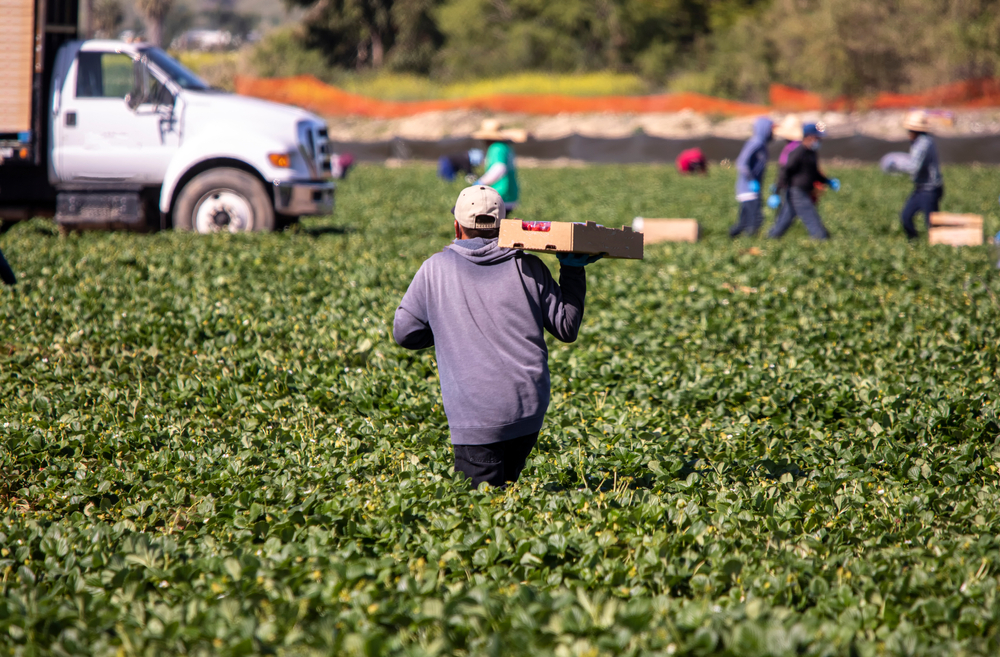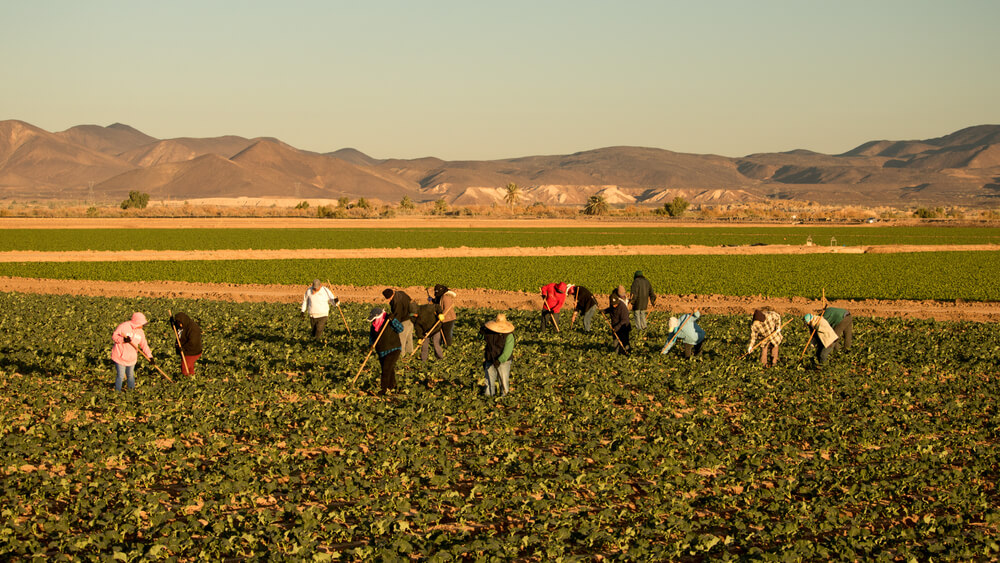Opinion: As the Heat Rises We Must Do Better at Protecting Agricultural Workers
The three-year average number of heat-related worker deaths has doubled since the early 1990s. Help has been too slow to materialize.
Opinion: As the Heat Rises We Must Do Better at Protecting Agricultural Workers
The three-year average number of heat-related worker deaths has doubled since the early 1990s. Help has been too slow to materialize.

Photography via Shutterstock.
On a hot day in Florida in 2016, Haitian tomato picker Jean Francais Alcime fell ill in the field from heat stress. His supervisor tried to help, giving him water and putting ice on his neck, and she thought he seemed better. But on the two-hour bus ride home, the worker still did not feel right, and he told the coworker next to him that he needed help. The co-worker called the supervisor, who said they should call the paramedics once the bus arrived home. But it would be too late. Once the bus arrived and they tried to wake the worker, they found he was no longer breathing.
Although tragic, stories of agricultural workers dying from heat exposure have only become more prevalent and, in some cases, gruesome in the years since this particular incident. Sometimes, workers collapse in the field and their bodies are not found until later. Often, affected workers are within their first week on the job. In many cases, the deaths could have been prevented with proper precautions, regulation, and information.
Recently, NPR and the Columbia Journalism Investigations team collaborated on an analysis of US Bureau of Labor Statistics (BLS) data, showing the three-year average of heat-related worker deaths has doubled since the early 1990s. Yet, the BLS estimate of 907 heat-related worker deaths from 1992-2019 is likely underreported. Heat is not always recognized as a contributor when a worker falls ill, and diagnosing a heat-related health event can vary by state, physician, or coroner. Relying on self-reports of adverse health outcomes, such as those involving heat, can lead to estimate errors; additionally, some adverse heat-related health outcomes may take years to manifest, such as congestive heart failure or chronic kidney disease, which present after prolonged or repeated cases of heat-related illness (HRI).
All outdoor workers who engage in manual labor in hot environments are at increased risk of HRI and connected injuries and deaths, but agricultural workers are at particular risk. They have poorer overall health outcomes than other populations. They often are not able to modify their work environments. And pay structures such as a piece rate can create an incentive to work intensely and not take breaks. Workers may also have immigration statuses that render them politically and economically disempowered. H-2A workers represent a particularly vulnerable group. They frequently do not speak English and do not have agency over matters such as transportation, housing, and worksite conditions. They may be reluctant to speak out about workplace conditions out of fear of losing their jobs, lack of language skills or lack of knowledge about resources.

In an effort to better understand the impact of HRI on agricultural workers, a collaborative team of academic and community-based researchers from Emory University, the Farmworker Association of Florida, and consultants from other institutions have examined the physical, environmental, and occupational disparities that can lead to increased vulnerability.
The team found that half of the workers surveyed exceeded a core body temperature of 38 degrees Celsius (100.4 degrees Fahrenheit), and that more than 80 percent of workers were dehydrated after their shifts. Around three percent even had acute kidney injury (AKI) related to dehydration. As temperatures increased, the odds of AKI also increased.
But there were relatively simple interventions that also proved helpful in pilot studies. Workers who wore cooling bandanas had lower odds of exceeding a core body temperature. Workers who consumed water with electrolytes had less indication of AKI.
These data help form a picture of agricultural workers and their workplace environments that can assist advocates and inform policymakers in efforts to pass sorely needed occupational heat standards. In the United States, occupational heat exposure is not federally regulated beyond a broad and general clause requiring employers to furnish worksites that are free from hazards that can cause harm to employees. There are no specific federal regulations, but in 2021, the US Department of Labor initiated rulemaking to address heat injury and illness prevention. However, the rulemaking process can take years to complete.
READ MORE
Farmworkers Cannot Wait for OSHA to Adequately Protect Them From Heat. The Fair Food Program Provides a Solution
Individual states can design and run their own OSHA-approved workplace safety and health programs and a few, including California, Washington, and Oregon, have incorporated heat exposure standards into their respective programs. Some municipal governments have also adopted their own heat campaigns and standards. Current efforts at the state and local level can provide valuable templates and lessons for federal efforts and for other states and municipalities considering protective measures.
As global temperatures continue to rise, it is inevitable that the rates of HRI and related injuries and deaths among high-risk occupational groups will also increase. Worker advocates are calling for OSHA to implement emergency preventative measures before a final federal rule is implemented. Such measures include regulating work pace and workloads during extreme temperatures, providing mandatory rest breaks and cooling spaces, requiring employers to keep strict records on the potential for workplace HRI, and mandating heat stress training for employees. The combination of these types of workplace protections, proactive measures from all levels of government, continuing community-engaged research, and community-level heat awareness campaigns represents the type of multi-faceted approach necessary to jumpstart a shift in current work culture and provide adequate safety for the nation’s most vulnerable workers.
Joan Flocks is the director emeritus of the Social Policy Division at the University of Florida (UF) Levin College of Law’s Center for Governmental Responsibility. She also previously served as the director of Emerging Issues at the UF Southeastern Coastal Center for Agricultural Health and Safety.
This article is based on a thought piece written for a colloquium hosted by the University of Pennsylvania’s Perry World House, “Living with Extreme Heat: Our Shared Future.”
Follow us
This work is licensed under a Creative Commons Attribution-NoDerivatives 4.0 International License.
Want to republish a Modern Farmer story?
We are happy for Modern Farmer stories to be shared, and encourage you to republish our articles for your audience. When doing so, we ask that you follow these guidelines:
Please credit us and our writers
For the author byline, please use “Author Name, Modern Farmer.” At the top of our stories, if on the web, please include this text and link: “This story was originally published by Modern Farmer.”
Please make sure to include a link back to either our home page or the article URL.
At the bottom of the story, please include the following text:
“Modern Farmer is a nonprofit initiative dedicated to raising awareness and catalyzing action at the intersection of food, agriculture, and society. Read more at <link>Modern Farmer</link>.”
Use our widget
We’d like to be able to track our stories, so we ask that if you republish our content, you do so using our widget (located on the left hand side of the article). The HTML code has a built-in tracker that tells us the data and domain where the story was published, as well as view counts.
Check the image requirements
It’s your responsibility to confirm you're licensed to republish images in our articles. Some images, such as those from commercial providers, don't allow their images to be republished without permission or payment. Copyright terms are generally listed in the image caption and attribution. You are welcome to omit our images or substitute with your own. Charts and interactive graphics follow the same rules.
Don’t change too much. Or, ask us first.
Articles must be republished in their entirety. It’s okay to change references to time (“today” to “yesterday”) or location (“Iowa City, IA” to “here”). But please keep everything else the same.
If you feel strongly that a more material edit needs to be made, get in touch with us at [email protected]. We’re happy to discuss it with the original author, but we must have prior approval for changes before publication.
Special cases
Extracts. You may run the first few lines or paragraphs of the article and then say: “Read the full article at Modern Farmer” with a link back to the original article.
Quotes. You may quote authors provided you include a link back to the article URL.
Translations. These require writer approval. To inquire about translation of a Modern Farmer article, contact us at [email protected]
Signed consent / copyright release forms. These are not required, provided you are following these guidelines.
Print. Articles can be republished in print under these same rules, with the exception that you do not need to include the links.
Tag us
When sharing the story on social media, please tag us using the following: - Twitter (@ModFarm) - Facebook (@ModernFarmerMedia) - Instagram (@modfarm)
Use our content respectfully
Modern Farmer is a nonprofit and as such we share our content for free and in good faith in order to reach new audiences. Respectfully,
No selling ads against our stories. It’s okay to put our stories on pages with ads.
Don’t republish our material wholesale, or automatically; you need to select stories to be republished individually.
You have no rights to sell, license, syndicate, or otherwise represent yourself as the authorized owner of our material to any third parties. This means that you cannot actively publish or submit our work for syndication to third party platforms or apps like Apple News or Google News. We understand that publishers cannot fully control when certain third parties automatically summarize or crawl content from publishers’ own sites.
Keep in touch
We want to hear from you if you love Modern Farmer content, have a collaboration idea, or anything else to share. As a nonprofit outlet, we work in service of our community and are always open to comments, feedback, and ideas. Contact us at [email protected].by Joan Flocks, Modern Farmer
July 28, 2023
Modern Farmer Weekly
Solutions Hub
Innovations, ideas and inspiration. Actionable solutions for a resilient food system.
ExploreExplore other topics
Share With Us
We want to hear from Modern Farmer readers who have thoughtful commentary, actionable solutions, or helpful ideas to share.
SubmitNecessary cookies are absolutely essential for the website to function properly. This category only includes cookies that ensures basic functionalities and security features of the website. These cookies do not store any personal information.
Any cookies that may not be particularly necessary for the website to function and are used specifically to collect user personal data via analytics, ads, other embedded contents are termed as non-necessary cookies.
EVERYONE working outside in hot weather deserves all the protection possible from the heat. Just the right thing to do.
The reall issue here js that the majority of farm laborers are paid by the piece not by the hour. They are incentivized to hustle, the faster you work the more money you make. So they literally run back and forth picking as long as the boss will let them. This is driven by market price which we as consumers are responsible for. I have a crazy idea for a win-win solution… plant rows of trees for shade and wind breaks. The trees could even be a crop! And maybe incentivize farmers to pay hourly so they dont pass on… Read more »